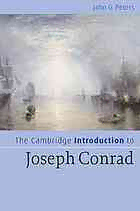Table Of ContentThis page intentionally left blank
The CambridgeIntroduction to
Joseph Conrad
JosephConradis one of the most intriguing andimportantmodernist
novelists.Hiswriting continues topreoccupy twenty-first-century
readers.This introduction bya leading scholar isaimed atstudents
coming toConrad’sworkfor the first time. The riseofpostcolonial
studies hasinspired new interest inConrad’sthemes of travel,
exploration, and racial and ethnicconflict. John Peters explains how
thesethemesareexploredinhismajor works,Nostromo,LordJim,and
‘‘Heart of Darkness’’ as well as his shorter stories. Heprovides an
essentialoverviewof Conrad’sfascinating life and career and his
approach towriting and literature.Aguide tofurther reading is
included, whichpoints tosome of the most useful secondarycriticism
onConrad.Thisisthemostcomprehensiveandconciseintroductionto
studying Conrad available,andit willbe essentialreadingfor students
of the twentieth-centurynovelandof modernism.
JOHN G. PETERS is Associate ProfessorofEnglish at theUniversityof
North Texas.
Cambridge Introductions to Literature
This series is designed to introduce students to key topics and authors.
Accessible and lively, these introductions will also appeal to readers who
wanttobroadentheirunderstandingofthebooksandauthorstheyenjoy.
(cid:1) Idealforstudents,teachers,andlecturers
(cid:1) Concise,yetpackedwithessentialinformation
(cid:1) Keysuggestionsforfurtherreading
Titles in this series:
Bulson TheCambridgeIntroductiontoJamesJoyce
Cooper TheCambridgeIntroductiontoT.S.Eliot
Dillon TheCambridgeIntroductiontoEarlyEnglishTheatre
Goldman TheCambridgeIntroductiontoVirginiaWoolf
Holdeman TheCambridgeIntroductiontoW.B.Yeats
McDonald TheCambridgeIntroductiontoSamuelBeckett
Peters TheCambridgeIntroductiontoJosephConrad
Scofield TheCambridgeIntroductiontotheAmericanShortStory
Todd TheCambridgeIntroductiontoJaneAusten
The Cambridge Introduction to
Joseph Conrad
JOHN G. PETERS
CAMBRIDGE UNIVERSITY PRESS
Cambridge, New York, Melbourne, Madrid, Cape Town, Singapore, São Paulo
Cambridge University Press
The Edinburgh Building, Cambridge CB2 8RU, UK
Published in the United States of America by Cambridge University Press, New York
www.cambridge.org
Information on this title: www.cambridge.org/9780521839723
© John G. Peters 2006
This publication is in copyright. Subject to statutory exception and to the
provision of relevant collective licensing agreements, no reproduction of any part
may take place without the written permission of Cambridge University Press.
First published in print format 2006
ISBN-13 978-0-511-56725-4 eBook (Dawsonera)
ISBN-13 978-0-521-83972-3 hardback
ISBN-13 978-0-521-54867-0 paperback
Cambridge University Press has no responsibility for the persistence or accuracy
of urls for external or third-party internet websites referred to in this publication,
and does not guarantee that any content on such websites is, or will remain,
accurate or appropriate.
For my grandfather, George L. Snider, and my late grandmother,
Ruth E. Snider
Contents
Preface page v iii
Acknowledgments x
Chapter 1 Conrad’s life 1
Chapter 2 Conrad’s context 19
Chapter 3 Conrad’s early period 37
Chapter 4 Conrad’s middle period 52
Chapter 5 Conrad’s la ter period 99
Chapter 6 Conrad criticism 119
Guide to further reading 136
Index 141
vii
Preface
Thisbookisintendedasageneraloverviewofthelife,works,andcontextof
Joseph Conrad. I hope that this study will be of use to both students and
scholars of Conrad, as well as to the interested non-specialist. The book
beginswithConrad’slife(particularlyinrelationtohiswritings),thenmoves
to the context in which he wrote, then considers Conrad’s fiction, and
concludes with the critical reception of Conrad’s works. In the process,
I have necessarily had to narrow mydiscussion to the most essential points.
I would have liked to have discussed Conrad’s non-fiction prose, but there
simply was not space enough to do so. In my discussion of Conrad’s works,
I have included, of course, my own thoughts on them, but I have also
included standard views of these works so that the newcomer to Conrad’s
works will have access to awide-ranging discussion.
UnlikemostoverviewsIhaveconsideredallofConrad’spublishedfiction
except The Sisters, the novel fragment that he abandoned some twenty-five
years or more before his death. I have also not considered the three works
upon which Conrad collaborated with Ford Madox Ford (The Inheritors,
Romance, and The Nature of the Crime) because these books were largely
Ford’swork.Ontheotherhand,Ihavecommentedoneveryotherfictional
workConradwrote,in cludingthestoriescollectedintheposthumousTales
of Hearsay, all of which were finished during Conrad’s lifetime, and the
posthumousunfinishednovelSuspense.UnlikemostoverviewsofConrad’s
works, I have not dismissed his less studied stories and novels but rather
have focused on such aspects of those works that I believe to be worth
considering. As a result, I hope that the student of Conrad will come away
with a better feel for Conrad’s entire career, not just for his middle career
for which he is best known. At the same time, however, I have spent the
bulkofmyeVortontheworksofConrad’smiddleperiod.Inconsideringall
of Conrad’s fiction works while emphasizing those of his middle period,
I hope I have presented a balanced and useful view of Conrad’s works and
career.
viii

